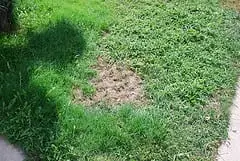Owning a dog can be one of life’s greatest joys, providing companionship and loyalty. However, this cherished bond comes with its own set of complications, one of which is the unsightly brown patches that litter our lawns due to dog urine. These spots can be particularly frustrating for pet owners who are passionate about maintaining their outdoor space. The following article analyzes the underlying causes of this issue while also providing practical solutions for dog owners eager to preserve both their pet’s well-being and the beauty of their lawns.
Brown patches on lawns are often attributed to the high nitrogen content in a dog’s urine. The nitrogen typically originates from the protein-rich diets many dogs consume. According to veterinary insight, the more protein your dog ingests, the greater the concentration of nitrogen in its urine. This is essential to know because it highlights that not all dogs are equally guilty of creating these unsightly spots—breed, diet, and metabolic health all play a role in this phenomenon.
While it might be tempting to switch to lower-protein dog foods in an effort to protect your lawn, this could compromise your dog’s health as they might not receive the nutrition they need. It’s crucial to prioritize your pet’s well-being while also looking for alternative solutions so that your dog remains happy and healthy without sacrificing your lawn’s aesthetics.
A common misconception among dog owners is to resort to fertilizers on affected lawn areas in an attempt to rejuvenate the grass. However, using fertilizers can exacerbate the problem because they are also high in nitrogen. This could further compound the damage rather than alleviating it. Thus, focusing solely on the chemical treatment of the yard is not a sustainable solution.
Veterinarian Denise Petryk urges a more holistic approach to lawn care by suggesting proactive measures. Paying attention to soil pH levels, introducing a consistent watering schedule, and aerating the soil are effective strategies in fostering a lawn that is more resistant to the harmful effects of urine. Moreover, selecting the right type of grass can significantly enhance a yard’s resilience against nitrogen deposits, making it vital to consider your lawn’s specific needs.
Implementing practical solutions can have a substantial impact on managing the effects of dog urine while fostering a lush lawn. One of the simplest methods to reduce nitrogen concentration is to control where a dog urinates. Using a leash during bathroom breaks allows pet owners to guide their dogs to designated areas, minimizing damage to the rest of the lawn.
Another effective tactic is to immediately water the grass after your dog has relieved itself. This dilutes the nitrogen concentration, lessening its harmful impact on the lawn. Encouraging your dog to drink more water can also help, as a well-hydrated dog will produce urine that is less concentrated with nitrogen. However, one must be cautious of unintended accidents indoors, as increased fluid intake also leads to more frequent restroom breaks.
Exploring alternative, high-quality dog food options is also wise. Consult your veterinarian for recommendations that can contribute to a more balanced nitrogen content in your dog’s urine, thus mitigating potential lawn damage.
An intriguing innovation in this realm is the introduction of products such as Dog Rocks, which aim to alter the nitrogen levels in a dog’s urine without resorting to chemicals. These naturally occurring rocks are designed to filter out impurities and help reduce the formation of urine burn patches. Although it does not remedy areas already damaged, it may help to prevent new ones from appearing.
However, while exploring options, it’s pertinent to prioritize your pet’s safety. Many products marketed for this problem may inadvertently pose health risks to your dog, given that their paws absorb many substances. It’s crucial for dog owners to weigh the risks of chemical treatments against the aesthetic appeal of a lawn.
Once brown patches have formed in your lawn, patience is key. Attempts to revive the grass with conventional methods often yield little success and can further exacerbate the issue. Allowing your grass time to recover on its own while avoiding areas of repeated dog urine will eventually lead to natural regeneration.
While maintaining a pristine lawn amidst the challenges of dog ownership can seem daunting, an informed and proactive approach can yield results. By understanding the cause of brown spots and implementing practical strategies, dog owners can protect both their pets and their precious yards. With time and dedication, it’s entirely possible to achieve a beautiful balance between dog companionship and maintaining an attractive outdoor space.

